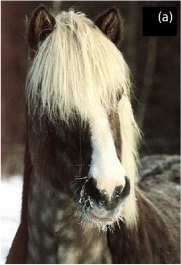
The silver or silver dapple (Z) gene is a dilution gene that affects the black base coat color and is associated with Multiple Congenital Ocular Abnormalities. It will typically dilute a black mane and tail to a silvery gray or flaxen color, and a black body to a chocolaty brown, sometimes with dapples.[1] It is responsible for a group of coat colors in horses called "silver dapple" in the west, or "taffy" in Australia. The most common colors in this category are black silver and bay silver, referring to the respective underlying coat color.[2]
Mature black silvers typically have sooty white or silver manes and tails with a flat, non-fading, dark grey or grey-brown body coat. The body coat frequently exhibits dapples, rings of lighter-colored hair.
Mature bay silvers retain their reddish bodies, though the presence of small amounts of silver often gives them a chocolate appearance. The mane and tail are usually a sooty silver, darker at the roots, and the legs are usually a flat, brownish-grey mottled with silver. The hair around the eyes and muzzle may also show signs of silvering.
Silver dapple foals can be difficult to identify, but commonly have a pale, wheat-colored body coat, white eyelashes, and hooves with tapering vertical stripes. These characteristics fade over time.[3]
Red-based horses, such as chestnuts and chestnuts with other dilution factors (such as palominos, and cremello) may carry the silver dapple gene, and may pass it on to their offspring, but will not express the gene in their own body color.[1]
- ^ a b "Horse coat color tests -Silver Dilution" from the UC Davis Veterinary Genetics Lab
- ^ Brunberg, Emma; Andersson, Leif; Cothran, Gus; Sandberg, Kaj; Mikko, Sofia; Lindgren, Gabriella (2006). "A missense mutation in PMEL17 is associated with the Silver coat color in the horse". BMC Genetics. 7: 46. doi:10.1186/1471-2156-7-46. PMC 1617113. PMID 17029645.
- ^ Brunberg, Emma (2006). "Mapping of the silver coat colour locus in the horse" (PDF). Institutionen för husdjursgenetik. Retrieved 2008-02-17.[permanent dead link]